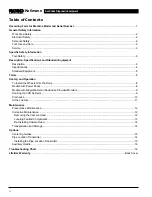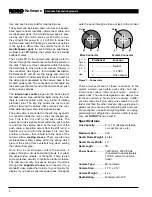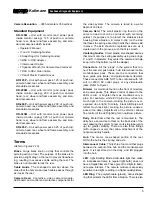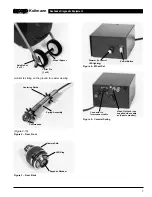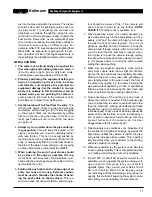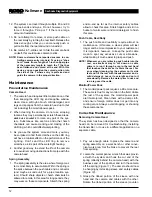
6. For additional troubleshooting suggestions, please
refer to Chart 1.
Re-Installing Camera Head
1. Lay out enough cable to lay the spring assembly on
a convenient work area and set the brake.
2. Plug the connector at the spring assembly into the
camera head, making sure that the guide pins/sock-
ets are aligned.
3. Grasp the camera head and safety cables with one
hand and turn the ribbed portion of the locking
sleeve to screw it into the back of the camera.
IMPORTANT: Try not to twist the cord or the camera,
only the locking sleeve. If this is done
properly, the cord and safety cables will
not be twisted around each other when
you view them from between the windings
of the spring.
4. Once the locking sleeve is tight into the back of the
camera, thread the spring onto the camera and,
using only your hands, screw the camera onto the
spring.
NOTE! The camera head will be properly mounted when
the end of the spring is snug between the cam-
era and the thread (not so far that it begins to
raise off the threads) and you cannot manually
unscrew the camera.
Transportation & Storage
1. Slip the camera into the reel with the rest of the push
cable. Turn the brake clockwise enough so that the
reel does not rotate unless you manually turn it.
2. Unplug the interconnect cable from the moni-
tor/power pack and wrap it loosely onto its storage
hooks located on the dolly.
3. If space allows, the reel/dolly should be laid on its
side during transportation and use. You will notice
that there is a second set of feet (three) on the side
of the reel where the interconnect cable is stored. If
there is not enough space to lay the system on its
side, stand it up and run a strap or cord through the
dolly and secure it to the vehicle.
4. Close the sunshade over the screen of the monitor
and wrap its outlet cord onto the hooks provided at
the rear.
5. Keep spare parts, tools, and the manual secure in
a work bag to protect them when not in use.
6. When possible, keep the system stored in a cool,
safe place. Leaving the camera pointed into the
sun or a high powered light source (when operat-
ing) can damage the imaging chip.
Options
Centering Guides: 3
″
and 6
″
The centering guides are designed to help center the
camera in various sized pipes, and also help keep the
camera out of the bottom sludge. Picture quality is
improved as they help position the camera towards
the middle of the pipe. This allows the camera to see
an equal amount of the pipe wall in all directions.
Do not assume that the guides are only helpful in 3
″
and 6
″
pipe! They also help in larger pipe by bringing
the camera closer to center and raising the camera
out of the sludge that is often found below the water
line. Keeping the camera off the bottom of the pipe
keeps the front of the camera cleaner, longer.
It is recommended that guides be used whenever pos-
sible (3
″
and up) as they protect the system from wear
and tear. However, if you are having trouble going fur-
ther in a particular pipe, try it without the guides. The
best advice is to experiment with local conditions and
decide what is best for the given job. One way to
increase their flexibility is to pre-strain them by bend-
ing the spikes back and forth a few times before use.
To install the guides, wind two metal snap rings per
guide into the push cable just like you would slip a key
onto a key ring. You should usually use 3 guides.
Position each guide where you want it on the spring,
with one of snap rings on either side. Look for grooves
on either side of the spikes on the guide and wind a
snap ring into each groove to lock it onto the spring.
When it is time to remove them, lift the edge of the
snap rings out of the grooves with the tip of a small
screwdriver and unwind them from the grooves. Slip
the snap rings off the spring/push cable and store
them with the guides for later use.
Pipe Location Transmitter
The pipe location transmitter allows the user to pin-
point the location and depth of the camera head
greater than 10 feet underground in cast iron pipe.
The transmitter emits a 512Hz signal that is sensed by
the receiver. The transmitter is designed to work with
manufacturer’s receivers who use 512Hz.
One of the great features of our transmitter is that it is
powered by the same power supplied to the camera
head. Once installed, it is always ready for use,
SeeSnake Diagnostic Equipment
Kollmann
14


